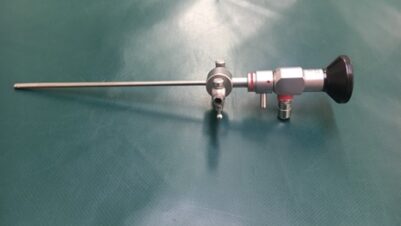Age-related changes in urine specific gravity in apparently healthy cats
Adam Rudinsky and others, Ohio State University, Columbus
Urine specific gravity (USG) is a low-cost and readily accessible screening tool for monitoring the health of feline patients. However, there is little published information in this species on the effects of ageing on USG. The authors examined data from more than 1,000 veterinary hospitals to assess the results of urinalyses of cats with an apparently healthy clinical status and complete diagnostic details. Their findings show that in the absence of any other disease indicators, renal concentrating ability begins to decline in cats at about nine years old and continues with increasing age. They state that this study provides important new information that will help improve screening practices for disorders that affect the ability of the feline kidney to concentrate urine.
Journal of Feline Medicine and Surgery, 26
Placement of an artificial urethral sphincter in dogs with urethral diverticulum
Geoffrey Neumann and others, University of Montreal, Quebec
Urethral diverticulum is a poorly defined congenital anomaly involving a pocket or “outpouching” of the urethral wall. It is a potential cause of urinary incontinence in male dogs, although it is much less common than urethral sphincter mechanism defects or ectopic ureters. The authors conducted a retrospective study of eight cases of urethral diverticulum in male dogs, which presented with persistent urinary incontinence that had failed to respond to medical management. The defect was identified through retrograde cystourethrography, cystoscopy, abdominal ultrasonography or contrast computed tomodensitometry. The dogs were treated surgically through the placement of an artificial urethral sphincter. Their findings show that this method is an effective therapeutic option that resulted in improved incontinence scores in every case.
Journal of Veterinary Internal Medicine, 38, 2171-2179
Clinical outcomes in the surgical treatment of ectopic ureters in cats
Gabriela Cortez and others, Massachusetts Veterinary Referral Hospital, Woburn
Ectopic ureter is a congenital condition in which one or both ureters terminate outside the bladder. The condition frequently leads to urinary tract infections and is often associated with other congenital abnormalities. The authors describe the signalment, surgical treatment, complications and outcomes in 12 cases of ectopic ureters in cats. Eight cats in this group had extramural ectopic ureters and six cats had bilateral abnormalities. Using a number of different surgical techniques, improvements in clinical signs were achieved in all cases and complete resolution occurred in 11 cats. One cat required an additional surgical intervention. Three cats experienced short-term complications and long-term issues occurred in another two cases.
Veterinary Surgery, 53, 1019-1028
Trends in the treatment of non-obstructive feline idiopathic cystitis
Laurel Krause and others, Ohio State University, Columbus
Feline idiopathic cystitis is the most common feline lower urinary tract disease, accounting for between 55 and 67 percent of cases. There are many treatment options including medical management, dietary changes and environmental modification, but there is no consensus on the most appropriate strategy. The authors conducted an internet survey completed by 606 US-based veterinarians on their preferred approach. Addressing stress factors, increased access to litter boxes and dietary changes were the most popular choices. But effective treatment appears to be multimodal with recommendations varying between acute and chronic presentations. High owner expectations and low compliance with veterinary recommendations were identified as barriers to improving the management of this condition.
Journal of Feline Medicine and Surgery, 26
Perineal urethrostomy in a castrated male pet rabbit with a urethral stricture
Stephanie Lamb, Arizona Exotic Animal Hospital, Mesa
Perineal urethrostomies are commonly performed on cats with urinary tract disorders resulting from obstructions, trauma or stenosis. The procedure involves anastomosing the urethra to the skin and creating a urinary stoma. The author describes the surgical treatment of a two-year-old neutered male rabbit that had been straining to urinate for several hours. One month previously the patient had undergone urethrotomy surgery to remove an obstructing urolith. On re-presentation, the clinical appearance and history suggested a urethral stricture. The procedure used was different in some respects to that normally adopted in the management of feline patients, but there were no significant post-operative complications and the clinical results were good.
Journal of Exotic Pet Medicine, 49, 18-22
Radiography in the investigation of cystine and urate cystoliths in dogs
Camille Andrews and others, University of Florida, Gainesville
Radiographs are commonly taken in the early stages of an investigation into cystoliths in canine patients. However, in human patients some of the more uncommon types of stone, such as cystine and urate salts, are usually considered to be radiolucent and therefore poorly visible with conventional radiography. The authors examined the clinical records from 331 dogs with cystoliths, including 31 found to have cystine-based stones and 49 that had urate stones. When examined prior to treatment, 92 percent of the cystine stones and 85 percent of the urate stones were radiopaque. Dietary management may help in controlling both types of urolith, but commercial diets used to dissolve struvite stones are likely to be ineffective. These findings can guide a clinician’s strategy when deciding between surgical and dietary approaches to treating these patients.
Journal of the American Veterinary Medical Association, 262
Effects of darbepoetin on blood parameters in cats with chronic kidney disease
Melissa De Lombaert and others, University of Georgia, Athens
Darbepoetin (DPO) is a recombinant human erythropoietin analogue developed to stimulate erythropoiesis in patients with chronic progressive anaemia, including those in which the condition results from chronic kidney disease. The agent has been shown to be effective in increasing red blood cell counts in human patients, but it has also been associated with platelet abnormalities. The authors investigated the effects of DPO in six healthy cats and six cats with a surgically induced model of chronic kidney disease. Their results show that DPO does not appear to have negative effects on platelet numbers, reactivity or reticulated platelet counts. Anaemic cats did show increased haematocrit and RBC reticulocytes as expected with DPO therapy.
American Journal of Veterinary Research, 85
Renal tubular acidosis in human and companion animal patients
Manju Gauri Kunchur and others, Thrive Pet Healthcare, Boise, Idaho
Renal tubular acidosis (RTA) has been the focus of numerous review articles in the human medical literature but there have been few similar publications in veterinary journals. RTA in people is frequently associated with genetic defects, but apart from a condition recognised in the Basenji breed, there has been little discussion of equivalent conditions in companion animals. The authors compare and contrast the information available on particular forms of RTA: acquired proximal and distal RTA, and congenital Fanconi syndrome in different species. They note that critically ill veterinary patients are often admitted to intensive care units for diseases associated with secondary RTA, or they may develop RTA while hospitalised. They state that the recognition and treatment of RTA may reverse tubular dysfunction and promote recovery by correcting metabolic acidosis.
Journal of Veterinary Emergency and Critical Care, 34, 325-355











